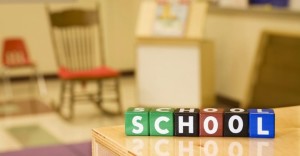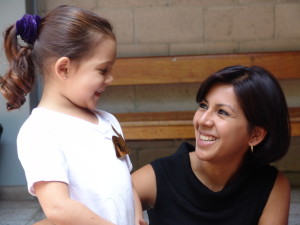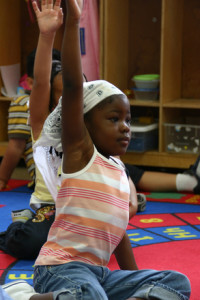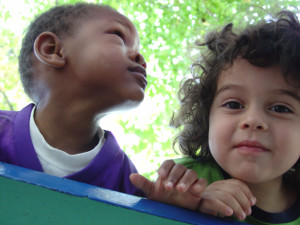この記事は次の言語でも読めます:日本語

I visited on of public elementary schools in the community the other day.
It is the smallest public school with 420 students in the district.
There are 75 students with disabilities.
Most of them have learning disabilities.
There are no students with mobility disability this year.
All students with disabilities learn with students without disabilities in the same classroom.
There are special education teachers and teaching assistants to support teachers to help student to learn, since students with disabilities sometimes have a hard time to speak, write, or understand in class.
In Japan, there is one teacher looking after 20-30 students in one class.
On the contrast, in this school, depending on the number of disabled students and the level of their needs, averagely 2-3 teachers and assistants are taking care of one class of students.
Each student with disabilities has IEP, Individual Education Plan.
Students take a test to know what kind of support they need.
The psychologists also evaluate what the students need and make a plan with necessary therapy services and reasonable accommodations to assist the students to learn.
The district pays for those service and accommodation, so the students’s family don’t need to worry about the expenses.
If students have test results, indicating they require high level of assistance, they may visit a private therapy outside of the school.
The school does annual review of IEP in Spring.
“Did we meet the goal?”, “What is the new goal for the next year? What should we focus on?”
Therapists, teachers, students, and parents discuss together.
Students with disabilities take this test every 3 years to see if they still need the service.
If they make progress faster, they could take a test sooner.
For students who are really sick or have severe disabilities (for example people who can’t breath or eat by themselves etc.) in the district, the therapist would visit these students’ houses to provide a therapy service.
This is also paid by the district.

There are many other people support students to learn besides teachers at school.
Special ed teacher:
Each grade has a special ed teacher to support a regular teacher.
For example, when a regular teacher gives 10 math questions to all students in the class, a special ed teacher will evaluate what the appropriate question amount is and says to a student with disability that “Try to answer 5 questions” if the good amount of question is 5 for the student.
Teachers and special ed teachers together provide a good learning environment for each students by considering the learning abilities of each student.
Occupational therapist:
The occupational therapist I interviewed at the school goes to other 2 different schools in addition to this school.
At this school, she comes twice a week.
She discusses each students’ learning progress with teachers, then she sets up small group therapy sessions for students who needs them.
In the therapy sessions, she helps students to learn how to better control their hands via cutting paper with scissors and writing trainings.
She also gives some suggestions to the students who cannot sit on a chair for a long time etc.
Speech therapist:
The speech therapist I interviewed works 5 days a week at the school.
Almost 35 students are taking her speech therapy sessions.
Many of them have language disabilities.
The counseling session is 30 minutes per time and it takes place 2 to 3 times a week.
Similar to occupational therapist, the speech therapist will discuss with the teacher in advance and sets up therapy sessions for students who need them.
She doesn’t directly teach the students math or reading, but help them to improve their language proficiency to learn math or reading.
For example, for an autism student, she teaches him or her sign language or words etc.
There are also physical therapist and mental health counselor in this school but, unfortunately, I was not able to meet them in person.

Here are examples of reasonable accommodations for the students with disabilities:
- Purchased a text reader for a legally blind student
- Prepare handouts with more detailed description in advance for students having difficulties on listening and writing (Other students get blank sheet and take memos by themselves.)
- Arrange bus rides to meet students’ needs: For students who cannot walk back home by themselves, the school still arranges bus rides for them even if their house is just across the street of the school. Their families have to pick them up when getting off the bus. Otherwise, the bus will take the students back to school.
Those reasonable accommodations are arranged both in public and private schools.
The cost will be covered by the district. In the U.S., the federal government has set up systems and rules, so states and schools have to abide them.
States and schools have to figure how to make it happen.
In Japan, mainly in public schools, necessary service and equipment are not provided enough due to the limited budget of the city.
I also went to a public school without elevator, and needed to go upstairs and downstairs by myself from 7 years old to 20 years old.
When I talked about the story at this school, everyone said “OH MY GOD!”
They even said “You could sue the school. It is totally illegal in the States!”

I would like to share the impressive comments from interviewees.
Kids are kids even if they have disabilities or not.
We can learn from each other.
Even teachers can learn from kids.
In this school, all kids grew up together in the same classroom.
They have studied and played together since they were little.
So when someone suddenly yell or start running, no one see him or her like ‘that’s weird’.
Because they know that is who he or she is.
In the US, children have more chances to know about people with disabilities…well I would say people with various backgrounds since they are little.
Those experiences might affect their behaviors such as open the door for wheelchair user.

I also had an opportunity to talk with the principal.
Due to the high-unemployment, poverty, and violence in this district, it is hard for the students to picture their bright future. This situation is one of disabilities.
Of course they are physically no limited, but influence mentally very much. For example, one of the teachers had a students 2 years ago at another school.
He was killed the other day.
He was only 15 years old.
This gave her a huge impact.
And the impact influenced to our students in this school too.
The high poverty, unemployment and the violence are creating trauma in our children.
And that trauma impacts their ability to learn.
My goal is to look at how we can counteract those trauma.
I would like to tell our students ‘The rest of your life is different!’ and continue to move them forward.
As she said, we have serious poverty situation in the city.
I cannot say it’s very safe place either.
In Japan, speaking of “people with disabilities”, we often think about physically disabled people who we often can observe and notice.
However, there are many invisible disabilities out there, and poverty is also included.
I have heard the poverty of children in Japan is also having serious social issues.
So this is something we have to think about too.

In the end…
I had studied in a regular class at public schools.
I could receive regular education and I got more chances to show people around me to get to know about my situation.
However, in terms of accessibility for a wheelchair user, it was never easy.
What the public schools have done for me was, equipped handrails on the side of stairs, renovated one bathroom to be accessible, and equipped ramps.
I and my family still appreciated it a lot.
However when I see the school in the States, I believe there should be a lot more things that Japan could do for students with physical, mental, intellectual disabilities.
In Japan, if students have disabilities, in many cases they cannot go to a public school in local community.
Or even if they could enter, they might be assigned to a special education classroom where all students with various kinds of disabilities.
The education level is lower than a regular class curriculum too.
I deeply feel that schools and teachers should see what each student need to learn and support them, not to rely on the education system which adults can manage easily.
